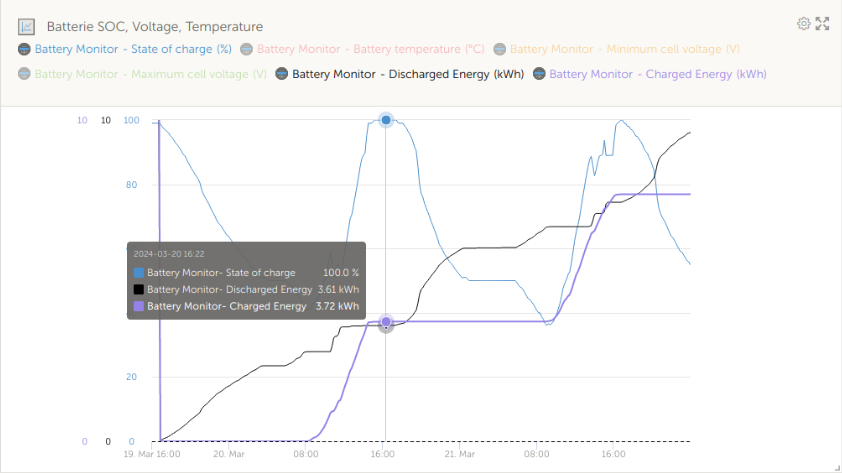Disclaimer : as usual, you shall understand the script before using it, and you are the only responsible if problems occurs using it.
Charged and discharged energy processing script for pylontech battery used with victron CerboGX / VenusOS The script is designed to run on a Victron CerboGX or Rpi with VenusOS
Its aim is to calculate /History/DischargedEnergy and /History/ChargedEnergy dbus value for battery bms which doesn't provide them. The dbus com.victronenergy.battery.xxxx /Dc/0/power is integrated every second to get them.
The result is injected on the dbus and then available in VRM
Discharged and Charged energy indexes are intialized with json file (/data/battery-energy-meter/energy.json or in case of service instalation, /data/battery-energy-meter/service/energy.json) on launching. Discharged and Charged energy indexes are saved in same json file when process is exited with SIGTERM or SIGINT signal.
Take care , that in case of mistake, especially if you modify the energy.json file manually during a period where the script is stopped. Some wrong value could be send to VRM which can impact statistics and reports displayed in VRM. Positive jumps on energy indexes can be understand by VRM as real charged ans discharged energy. Negative jumps seem not to be taken in accountand processed as erroneous data.
You need at least basic knowledge in linux command tool. You need to have ssh and sftp access to your CerboGX. The way to do it is explained here. Then log with ssh, create a battery-energy-meter in /data and a battery-energy-meter in /var/log ''' mkdir /data/battery-energy-meter mkdir /var/log/battery-energy-meter ''' Then, with sftp, copy content of this repository src directory into /data/battery-energy-meter
cd /data/battery-energy-meter
python battery-energy-meter.py
and then you can display logs in real time in another terminal with
tail -f /var/log/battery-energy-meter
Use Ctrl-C to stop the script
cd /data/battery-energy-meter
nohup python battery-energy-meter.py&
To kill the script :
pkill -f "python battery-energy-meter.py"
Add the line "ln -s /data/battery-energy-meter/service /service/battery-energy-meter" to the /data/rc.local file and reboot the CerboGX
After that you can use svc command to control the service
To stop the service with indexes backup :
svc -d /service/battery-energy-meter
To stop and restart the service with indexes reset to 0 :
svc -h /service/battery-energy-meter
To stop the service without indexes backup :
svc -k /service/battery-energy-meter
To start the service :
svc -u /service/battery-energy-meter
Stop the service
Clear the energy.json file
Start the service
svc -d /service/battery-energy-meter
rm /data/battery-energy-meter/service/energy.json
svc -u /service/battery-energy-meter
You can now display charged (curve purple) and discharged ( curve black) in VRM. Indexes have been set to zero when SOC is 100 %

So you can check that after one discherged/charged cycle (one Pylontech US5000 battery), discharged energy is 3.61 kWh, charged energy is 3.72 kWh which allow to calculate an efficiency of 97%.